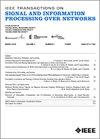Learning Graph Filters for Structure-Function Coupling Based Hub Node Identification
IF 3
3区 计算机科学
Q2 ENGINEERING, ELECTRICAL & ELECTRONIC
IEEE Transactions on Signal and Information Processing over Networks
Pub Date : 2025-08-01
DOI:10.1109/TSIPN.2025.3595070
引用次数: 0
Abstract
Over the past two decades, tools from network science have been leveraged to characterize the organization of both structural and functional brain networks. One such tool is hub node identification. Hubs are nodes within a network that link distinct brain units corresponding to specialized functional processes. Conventional methods for identifying hubs utilize different types of centrality measures and participation coefficient to profile various aspects of nodal importance. These methods solely rely on the functional connectivity networks constructed from functional magnetic resonance imaging (fMRI), ignoring the structure-function coupling in the brain. In this paper, we introduce a graph signal processing (GSP) based framework that utilizes both the structural connectivity and the functional activation to identify hubs. The proposed framework models functional activity as graph signals on the structural connectivity. Hub nodes are then detected based on the premise that they are sparse, have higher level of activity compared to their neighbors, and the non-hub nodes’ activity is the output of a low-pass graph filter. Based on these assumptions, an optimization framework, GraFHub, is formulated to learn the coefficients of the optimal graph filter and detect the hub nodes. The proposed framework is evaluated on both simulated data and resting state fMRI (rs-fMRI) data from Human Connectome Project (HCP).基于结构-功能耦合的集线器节点识别学习图滤波器
在过去的二十年里,网络科学的工具被用来描述结构和功能大脑网络的组织。集线器节点标识就是这样一个工具。中枢是网络中的节点,连接着与特定功能过程相对应的不同脑单元。识别枢纽的传统方法利用不同类型的中心性度量和参与系数来描述节点重要性的各个方面。这些方法仅仅依赖于功能性磁共振成像(fMRI)构建的功能连接网络,而忽略了大脑中的结构-功能耦合。本文介绍了一种基于图形信号处理(GSP)的框架,该框架利用结构连通性和功能激活来识别集线器。该框架将功能活动建模为结构连通性的图信号。然后,基于以下前提检测集线器节点:它们是稀疏的,与它们的邻居相比具有更高的活动水平,非集线器节点的活动是低通图过滤器的输出。基于这些假设,我们构建了一个优化框架——GraFHub,来学习最优图滤波器的系数并检测hub节点。所提出的框架在人类连接组计划(HCP)的模拟数据和静息状态fMRI (rs-fMRI)数据上进行了评估。
本文章由计算机程序翻译,如有差异,请以英文原文为准。
求助全文
约1分钟内获得全文
求助全文
来源期刊

IEEE Transactions on Signal and Information Processing over Networks
Computer Science-Computer Networks and Communications
CiteScore
5.80
自引率
12.50%
发文量
56
期刊介绍:
The IEEE Transactions on Signal and Information Processing over Networks publishes high-quality papers that extend the classical notions of processing of signals defined over vector spaces (e.g. time and space) to processing of signals and information (data) defined over networks, potentially dynamically varying. In signal processing over networks, the topology of the network may define structural relationships in the data, or may constrain processing of the data. Topics include distributed algorithms for filtering, detection, estimation, adaptation and learning, model selection, data fusion, and diffusion or evolution of information over such networks, and applications of distributed signal processing.
 求助内容:
求助内容: 应助结果提醒方式:
应助结果提醒方式:


